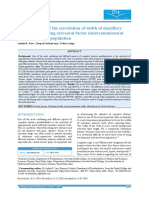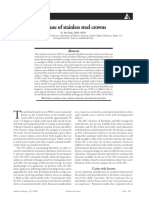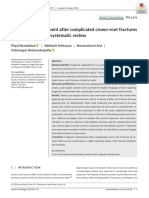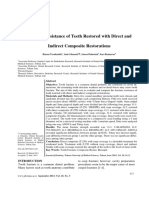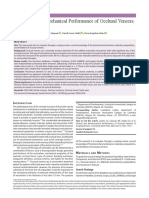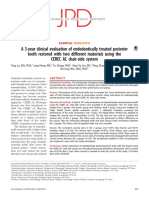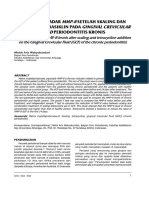A Randomised Controlled Trial of Three Aesthetic Full-Coronal Restorations in Primary Maxillary Teeth
Uploaded by
jazi nesrineA Randomised Controlled Trial of Three Aesthetic Full-Coronal Restorations in Primary Maxillary Teeth
Uploaded by
jazi nesrineSee discussions, stats, and author profiles for this publication at: https://www.researchgate.
net/publication/298286719
A randomised controlled trial of three aesthetic full-coronal restorations in
primary maxillary teeth
Article in European Journal of Paediatric Dentistry · March 2014
CITATIONS READS
0 961
1 author:
Anas Al Salami
Mohammed Bin Rashid University of Medicine and Health Sciences
17 PUBLICATIONS 72 CITATIONS
SEE PROFILE
Some of the authors of this publication are also working on these related projects:
Oral Health Status Of Children of Incarcerated Mothers at UAE Jail Nurseries and Oral Health Knowledge & Attitudes of Their Caregivers. View project
All content following this page was uploaded by Anas Al Salami on 15 March 2016.
The user has requested enhancement of the downloaded file.
Introduction
T. Walia, A. A Salami, R. Bashiri, O. M Hamoodi,
F. Rashid Early Childhood Caries (ECC) continues to be a public
health problem of global proportions, which entails the
Department of Growth and Development, College of Dentistry, early carious involvement of the primary maxillary incisors
Ajman University, Ajman, UAE followed by the maxillary and mandibular first primary
molars and the mandibular cuspids [Wayne, 2001].
e-mail: ttww@yahoo.com Aesthetic restoration of these carious or traumatised
primary anterior teeth can be challenging especially
due to their small size, close proximity of pulp, relatively
thin enamel leading to lesser surface area for bonding
A randomised as well as issues related to child behaviour and cost of
treatment [Donly, 2002; Usha et al., 2007]. Nonetheless,
controlled trial of three it is essential to restore them in order to preserve the
integrity of primary teeth until their exfoliation and
aesthetic full-coronal eruption of permanent teeth [Mendes et al., 2004].
Numerous treatment approaches have been proposed
restorations in primary to address the aesthetics and retention of restorations
in these teeth. Intra-coronal tooth-colored restorations
maxillary teeth include glass ionomer cements, resin-modified glass
ionomers (RMGI), polyacid-modified resins or resin
composites. Full-coronal aaesthetic restorations can also
be used such as free-hand buildup of crown structure
abstract with tooth-colored materials like RMGI [Mandrolip,
2003] and composite, using celluloid strip crowns
Aim This randomised clinical trial (RCT) compared the [Mendes et al., 2004], or ready-made crowns like pre-
clinical outcomes of three aesthetic full-coronal restorations veneered stainless steel crowns [Usha et al., 2007], and
(composite strip crowns, pre-veneered stainless steel the recently introduced pre-fabricated primary zirconia
crowns (SSCs) and pre-fabricated primary zirconia crowns) crowns. Each method of restoration has its own distinct
in carious and traumatised primary maxillary incisors. advantages and disadvantages.
Materials and methods One hundred and twenty The aim of this clinical research was to evaluate and
nine teeth in 39 children aged between 3 to 5 years were compare three aesthetic full-coronal restorations on
included. Children were randomly assigned to one of three primary maxillary central and lateral incisors over a period
treatment groups using a permuted block randomisation of 6 months in terms of restoration failure, abrasion on
technique with a total of 43 teeth in each group. After the opposing dentition and gingival response. The three
trainee calibration, restorations were placed and evaluated restoration types included were Resin Composite Strip
after 6 months. Outcomes evaluated were restoration Crowns, Pre-Veneered Stainless Steel Crowns, and the
failure, tooth wear of opposing teeth and gingival health. newly introduced Pre-Fabricated Primary Zirconia Crowns.
Results The retention rate was highest for zirconia
crowns (100%) followed by pre-veneered SSCs (95%).
Strip crowns were the least retentive (78%). Zirconia Materials and methods
crowns showed low grade abrasion in four opposing teeth.
Teeth restored with resin composite and pre-veneered SSC Study design
showed an increase in mean gingival index score, while The design of this randomised controlled clinical trial
corresponding values decreased in zirconia crowns. followed the guidelines published by Consolidated
Conclusion Resin composite strip crown is a highly Standards of Reporting Trials (CONSORT) [Schulz et al.,
sensitive technique leading to lower retention rate. 2010]. The study was approved by the Research Ethics
Pre-veneered stainless steel crowns showed increased Committee of the College of Dentistry, AUST (no. 12-
incidence of facial veneer fracture. Zirconia crowns are 02). Prior to enrollment, every child’s parent/guardian
highly retentive and biocompatible but cause low grade received and signed an informed consent form.
of abrasion of their opposing natural dentition at the
6-month follow-up. Sample size
Based on the primary outcome of restoration failure,
and looking for a clinically important difference in
Keywords Aesthectics; Full-coverage restoration; proportion of restoration failures of 25% between
Primary incisors. groups (2-tailed alpha=0.05 and power of 0.80), a
minimum of 35 crowns were required in each group,
European Journal of Paediatric Dentistry vol. 15/2-2014 113
Walia T. et al.
totaling 105 teeth. Given the possibility of 10% attrition and dentine only; primary maxillary incisors with at least
in subsequent follow-ups, an additional 24 teeth were two third of the root length; adequate root support with
included in the study ensuring 43 primary incisors in no mobility. Children would to be managed by behavioral
each group. Therefore, a total sample of 129 teeth was management techniques and physical restraint only.
included at baseline. The subjects were allocated to one Randomisation was done by a statistician using permuted
of the following groups. block randomisation. Randomisation was conducted on
• Group A (Fig. 2): Resin composite strip crowns children rather than individual teeth. Block sizes of three
(Pedoform strip crowns forms, 3M® St. Paul MN). individuals were used. Each block consisted of children
• Group B (Fig. 3): Pre-veneered stainless steel crowns who required similar number of full coronal restorations.
(NuSmile® Pediatric Crowns, Houston, TX). Therefore, a child who required multiple restorations was
• Group C (Fig. 4): Pre-fabricated primary Zirconia only entered in the study when two other children who
crowns (Zirkiz® crowns, Hass, South Korea). required a similar number of restorations were available.
Forty-three children were randomly assigned as per the
Eligibility criteria and randomisation permutation within each group; however children could
Forty six children/148 teeth were examined initially not be randomised on the basis of their dmft status as it
and 39 children/129 teeth were then selected who met was difficult to find permuted blocks with similar number
the inclusion/exclusion criteria described in Figure 1. of children having the same dmft and number of teeth to
Subjects selected had 3-5 years of age, enjoyed good be replaced. The distribution of 43 teeth in each group at
general health, had the mandibular primary incisors baseline is shown in Table 1.
present and showed carious primary maxillary incisors,
with minimum of two surfaces involved, out of which Trainees’ calibration
one must be palatal caries and with DMFT of ≥3 (WHO Prior to study initiation, three trainees were calibrated on
Index) [Federation Dentaire Internationale, WHO, 2006]; tooth preparation and crown placement on 10 children,
moreover, primary maxillary incisors requiring full coronal total of 21 crowns, 7 crowns for each group. In order to
restoration following trauma involving enamel or enamel maintain consistency in restoration methods, each intern
was evaluated by two specialists with regards to their
clinical technique, and rated for each restoration prepared
on a Likert scale from 1-5, 1 being not acceptable, and
5 being highly acceptable. The consistency in ratings
between specialists for each trainee was also tested for
consistency using the Kappa test. During the calibration
for consistency in restoration methods, specialists
consistently scored high ratings for the restorations by
each intern, emphasised by a high Kappa score of 0.93.
Each intern prepared only one type of crown. A general
dental practitioner (GDP) was also selected and trained in
evaluation of: restoration failure; abrasion in the opposing
dentition (visual and photographical assessment method);
gingival health of the restored teeth and; photographic
technique. Ten percent of results of the 21 crowns
(i.e. three crowns), were re-evaluated to confirm the
reproducibility of the evaluation scores.
Methods of outcome measures evaluation
At baseline, only gingival health was measured, while
at the 6-month follow-up, all three outcome measures
were evaluated. The description of the criteria used to
record the clinical parameters is shown in Table 2.
Evaluation of restoration failure
This was clinically evaluated with visual assessment of
the restoration, according to the US Public Health Service
“USPHS”, Alpha criteria rating system [Ryge, 1980].
Evaluation of tooth wear on opposing teeth
Tooth wear was evaluated according to the Smith
fig. 1 Flow-chart of the trial. and Knight Tooth Wear Index [Bardsley, 2008; Smith
114 European Journal of Paediatric Dentistry vol. 15/2-2014
comparison of full crown restorations
No. of teeth No. of Total (43) Criteria Grades Description
restored per children in Restoration 0 Crown appears normal: no
child each group failure cracks, chips, or fractures
1 1 1 1 Small but noticeable area of loss
of material
2 1 2
2 Large loss of crown material
3 4 12
3 Complete loss of crown
4 7 28
Tooth wear 0 No loss of enamel surface
tabLE 1 Distribution of 43 teeth in each group at baseline. characteristics, no loss of contour
1 Loss of enamel surface
characteristics, minimal loss of
and Knight, 1984]. The incisal and labial surfaces of contour
the teeth opposing the full-coronal restorations were 2 Loss of enamel exposing dentine
clinically observed for any sign of abrasion. In addition, for less than one third of surface,
loss of enamel just exposing
photographs were taken with a Canon Digital SLR® dentin, defect less than 1 mm
camera using focus 1:3 frontal, teeth parted, 1/60 sec, f deep
22 and 1:1.5 frontal upper 1/60 sec, f 22 at baseline and 3 Loss of enamel exposing dentin
at the 6-month follow-up. for more than one third of
surface, loss of enamel and
substantial loss of dentin, defect
Evaluation of gingival health less than 1–2 mm deep
This parameter was evaluated using a blunt periodontal 4 Complete enamel loss, pulp
probe (Double ended probe Williams 1-2-3-5-7-8-9- exposure, secondary dentin
10 Goldman Fox Flat) according to the Löe and Silness exposure, pulp exposure or
exposure of secondary dentin,
gingival index [Löe, 1967]. After the selection of correct defect more than 2 mm deep,
crown size, proper isolation with rubber dam and local pulp exposure, secondary dentin
exposure IMMAGINO SIA COSI’,
anaesthesia were achieved. Caries was excavated and NON SI CAPIVA COME LO
in cases of very deep lesions, an application of a resin AVEVANO SCRITTO
modified GIC liner/base (Viterbond, 3M-ESPE Dental Gingival 0 No obvious signs of inflammation
products, St.Paul, Minn®) was applied for pulp protection. Health
The tooth was prepared using a No. 330 carbide bur to 1 Mild marginal gingivitis, tissue
reduce the incisal edge by approximately 1.5 mm and the slightly reddened and edematous
interproximal contact opened. A coarse tapered round 2 Moderate marginal gingivitis-
diamond bur was used to reduce the tooth both labially tissue obviously reddened and
swollen
and palatally by 1-1.5 mm, followed by a fine tapered
round-end diamond bur to smoothen the preparation 3 Severe gingivitis, tissue is very
swollen: spontaneous bleeding
and to refine it 1 mm subgingivally. The tooth preparation
principles followed were similar in all three groups. tabLE 2 Distribution of 43 teeth in each group at baseline.
Resin composite strip crown placement
procedures subgingivally. The shape and length modification of
After cutting the gingival margin of the celluloid crown the crown was kept as minimum as possible in order to
form to achieve a good fit, the shade of the resin composite have a proper fit if required. Contouring and crimping of
(3M, Filtek™ Z250 Universal Restorative®) was chosen and the lingual aspect was done. Final fit of the crown was
squeezed into the celluloid crown form. The tooth surfaces confirmed and cemented with type II GIC (Ketac® 3M
were etched for 20 seconds with a 37% phosphoric acid ESPE, St.Paul, Minn) applying digital pressure only.
solution (3M™ ESPE™ Etching Liquid®), and then the
light cure bonding adhesive (3M, Scotchbond-Universal- Pre-fabricated primary zirconia crown
Adhesive-Refill-Vial-41258®) was brushed onto the placement procedure
etched tooth surfaces. The celluloid crown then inserted After a trial fit of the crown, adjustments were done for
and excess resin was removed and polymerised, followed labial and lingual borders only if required, with high-speed
by celluloid crown form removal. Finishing and occlusal fine diamond bur under lot of water because excess heat
adjustments were performed, if required, using polishing could cause micro-fractures in the crown. Final passive fit
discs (3M ESPE, Sof-Lex® Polishing-Strip). of the crown was confirmed and cemented with type II
GIC (Ketac® 3M ESPE, St.Paul, Minn).
Pre-veneered SSC placement procedures
A trial fit of the crown was carried out after the tooth Statistical analysis
reduction ensuring that it did not sit more than 1 mm Comparisons of the age of participants as well as
European Journal of Paediatric Dentistry vol. 15/2-2014 115
Walia T. et al.
baseline gingival health scores between groups were Primary Maxillary Incisors Count (%)
performed using a one way ANOVA and post hoc Tukey Right Lateral (52) 33 (26%)
tests. Changes in gingival health within each group
Right Central (51) 32 (25%)
between baseline and 6 months were evaluated using
paired sample T tests. Comparisons of change in gingival Left Central (61) 34 (26%)
health between the three groups were also evaluated Left Lateral (62) 30 (23%)
using a one way ANOVA and post hoc Tukey tests. Chi
square analyses for proportions were applied to test for tabLE 3 Baseline data of teeth restored.
differences in restoration failure and tooth wear indices
between groups at 6 months. Analyses were performed Outcome Group A Group B Group C
using the Statistical Package for Social Sciences (SPSS, Measures (n=36) (n=37) (n=38)
versions 20.0.0 for Windows). grades n (%) n (%) n (%)
Restoration 0 28 (78%) 35 (95%) 38 (100%)
failure
Results 1 2 (5%) 2 (5%) 0 (0%)
2 0 (0%) 0 (0%) 0 (0%)
Full-coronal restorations were placed on 129 primary 3 6 (17%) 0 (0%) 0 (0%)
maxillary incisors consisting of 66 central and 63 lateral
Tooth wear 0 31 (100%) 32 (100%) 34 (90%)
incisors of 39 children (21 male, 18 female) (Table 3) The
average age of children at the baseline was 4.5 years and 1 0 (0%) 0 (0%) 4 (10%)
dmft -5. There was a drop out of 6 children/18 teeth
tabLE 4 Restoration failure and tooth wear results at the
at the 6-month follow-up reducing the sample to 33
6-month follow up.
children /111 teeth.
Restoration failure Tooth wear of opposing dentition
Two crowns each out of 36 resin composite strip Four opposing primary dentition of 38 pre-fabricated
crowns (group A) and 37 pre-veneered SSCs (group B) primary zirconia crowns (group C) had shown loss of
respectively had small but noticeable areas of loss of enamel surface characteristics - minimal loss of contour
material, while 6 out of 31 resin composite strip crowns which was statistically not significant but could be
(group A) were completely lost after 6 months (Table 4). clinically significant. None of the resin composite strip
When comparing the 3 groups, there was a statistically crowns (group A) and pre-fabricated Zirconia crowns
significant difference between groups A and B (p=0.04) (group B) showed any sign of tooth wear. When
and between groups A and C (p=0.02) (Table 5). comparing the tooth wear results between the groups,
fiG. 2 Resin composite
strip crowns (complete loss
of restorations of central
incisors) before treatment (a)
and after six months (b).
fig. 3 Pre-veneered SS
crowns before treatment (a)
and after six months (b)..
fig. 4 Pre-fabricated primary
zirconia crowns before
treatment (a) and after six
months (b).
116 European Journal of Paediatric Dentistry vol. 15/2-2014
comparison of full crown restorations
Mean Gingival Mean Gingival Difference p value tabLE 5
Health Health in MGH Mean gingival
(baseline) (6 months) health score
Strip Crown n 43 36 of 3 groups at
baseline & after
Mean (SD) 1.65 (0.50) 1.97 (0.44) 0.32 < 0.05
6 months.
NuSmile Crown n 43 37
Mean (SD) 1.71 (0.50) 1.95 (0.61) 0.24 0.07
Zirkiz Crown n 43 38
Mean (SD) 1.67 (0.56) 1.35 (0.60) -0.32* < 0.05
* MGH score reduced over a period of 6 months
there was no statistically significant difference between Groups Restoration Tooth Gingival
them at the 6-month follow-up (Table 6). Failure Wear Health
Group A - B 0.04 NA 0.93
Gingival health of the restored teeth Group B - C 0.23 0.239 0.00
At baseline there was no statistically significant
difference in mean gingival health scores (MGI) between Group A - C 0.02 0.238 0.00
the groups. At the 6-month follow up, the mean was tabLE 6 – p-value of comparison between groups.
increased in group A and B, while in teeth restored with
Zirkiz crowns (group C) the MGI score was significantly
reduced (p=0.01). When comparing the difference in the overall retention as these teeth are usually more
the mean gingival health between all groups, there was destructed [Kupietzky et al., 2005].
statistically significant difference only between groups A
and C and B and C (p=0.00) (Table 6). Pre-Veneered SSC
Preveneered SSCs are a good restoration for anterior
teeth with significant decay and do not require extensive
Discussion additional chair time [Shah et al., 2004]. Long-term
retention and resistance to fracture of the veneer has
Primary incisors have enjoyed less retention of been shown to be somewhat low [Gupta et al., 2008].
intracoronal restorations with tooth colored materials The dentist is limited in the choice of resin shades,
such as composite, compomer and conventional or resin and the crowns are sometimes so white that they
modified glass ionomer due to morphology of the pulp, appear artificial [Croll and Helpin, 1996; Croll, 1998;
dentin and enamel as reported by Waggoner [1994], Wickersham et al., 1998]. In the present study, only 5%
Piyapinyo and White [1998] and Kopel & Beaver [1967]. of the NuSmile crowns failed. This occurred due to partial
loss of composite veneer at the metal-resin interface
Composite strip crowns which is machine compressed on the metal labial surface
The success rate of these crowns in our study after of the crown but they were never dislodged. Waggoner
6 months was 78% and only behavior management [1994] stated that breakage of the veneer is probably
techniques and physical restraints were used to manage due to traumatic forces, and not incisive forces. Lin
the children. However, they were still uncooperative, [2005] concluded in his study that, due to the physical
restless and stressed during the treatment, which made properties associated with resin veneers over stainless
moisture control inadequate for this highly technique steel, the resin has minimal flexure and can dislodge
sensitive restoration. Eidelman et al. [1997] reported with the tensile and shear stress associated with typical
better results for strip crowns placed by graduate mastication. A lower failure rate of these crowns in our
students under general anaesthesia than for those done study can also be attributed to the fact that children
under sedation. General anaesthesia allows treatment with increased overjet and overbite were excluded and
to be rendered under theoretically optimal conditions; secondly, they were followed-up for only 6 months.
implying outcomes would be more successful. Success
rate between 80% - 88% were found in the studies Pre-fabricated primary zirconia crown
done by Waggoner et al. [2005]; Ram and Fuks [2006] Current research on the clinical success of prefabricated
and Kupietzky et al. [2003]. High failure rate of 51% primary zirconia crowns for primary incisors is limited. In
over period of 2 years was seen in a study by Tate et al. the present study, the retention rate of Zirkiz crowns was
[2002], where strip crowns were placed under general 100% after 6 months. These monolithic crowns have
anaesthesia and endodontically treated teeth were no facial upper structure, as they are made up of solid
included as well. Endodontic treatment can also affect zirconia leading to no chance of facial veneer fracture
European Journal of Paediatric Dentistry vol. 15/2-2014 117
Walia T. et al.
[Manicone et al., 2007]. The flexural strength of zirconia Conclusion
oxide materials has been reported to be in the range of
900 to 1,100 MPa. This is approximately twice as strong Resin composite strip crowns have lower success rate
as alumina oxide ceramics currently in the market and 5 and higher gingival inflammation. Pre-veneered SSCs are
times greater than standard glass ceramics [Manicone et retentive, but can have facial veneer fracture. Pre-fabricated
al., 2007]. Another important property is their fracture zirconia crowns are retentive and gingival friendly but cause
toughness making them perdurable and a highly strong non-significant abrasion of opposing teeth.
restoration [Denry and Holloway, 2010].
Conflict of interest statement
The authors declare that they do not have any
Tooth wear commercial or associative interest that represents a
A slight tooth wear in natural dentition is considered conflict of interest in connection with this work.
normal [Warren et al., 2002]. If restorative dental materials
have different wear properties compared to the natural References
teeth, they can affect the wear rate of antagonist natural › Bardsley PF. The evolution of tooth wear indices. Clin Oral Invest (2008) 12 (Suppl 1):S15–S19.
teeth [Sulong and Aziz, 1990]. Therefore, wear occurring › DeLong R, Sasik C, Pintado MR, Douglas WH. The wear of enamel when opposed by ceramic
systems. J Dent Mater 1989; 5: 266- 271.
between enamel and dental restorations is an important › Denry I, Holloway JA. Ceramics for dental applications: a review. J Dent Mater 2010;3:351–368.
› Donly K. Pediatric Restorative Dentistry. Consensus Conference. April 15-16, 2002. San Antonio,
factor that should always be considered in the selection Texas. Pediatr Dent 2002;24:374-376.
of restorative materials in clinical practice [Delong et al., › DonovanTE.Factorsessentialforsuccessfulall-ceramicrestorations.JAmerDentalAssoc2008;139:14S-18S.
› Eidelman E, Faibis S, Peretz B. A comparison of restorations for children with early childhood caries
1989]. Seghi et al. [1991] has suggested that a restorative treated under general anesthesia or conscious sedation. Pediatr Dent.1997; 22:33-37.
dental material should have a wear degree similar to that › Federation Dentaire Internationale (FDI) World Health Organization (WHO), International Association for
Dental Research (IADR) Joint Statement from the European Dental Caries Conference, 2006.
of the enamel. There are different methods of tooth wear › Gupta M, Chen JW, Ontiveros JC. Veneer Retention of Preveneered Primary Stainless Steel
Crowns after Crimping. J Dent Child 2008;75:44-47.
evaluation such as using a three-dimensional profiling › Hackmyer SP, Donly KJ. Restorative dentistry for the pediatric patient. Tex Dent J. 2010; 11:1165-1171.
system and ANSUR 3D software [Jung et al., 2010], but they › Jung YS, Lee JW, Choi YJ, Ahn JS, Shin SW, Huh JB. A study on in-vitro wear of the natural tooth
structure by opposing zirconia or dental porcelain. J Adv Prosthodont. 2010; 2: 111-115.
are not easy to perform in children. Recent research from › Kopel HM, Beaver HA. Comprehensive restorative procedures for primary anteriors. ASDC J Dent
Child. 1967;34:412-423.
the University of Zurich also demonstrated that improperly › Kupietzky A, Waggoner WF, Galea J. The clinical and radiographical success of bonded resin
polished and only glazed zirconia can be destructive to the composite strip crowns for primary incisors. Pediatr Dent. 2003;25:577-581.
› KupietzkyA,WaggonerWF,GaleaJ.Long-termphotographicalandradiographicassessmentofbonded
opposing tooth structure [Donovan, 2008]. resin composite strip crowns for primary incisors: results after 3 years. Pediatr Dent. 2005;27:221-225.
› Lee JK. Restoration of primary anterior teeth: a review of literature. Pediatr Dent. 2002; 24: 506-511.
› Lin B. Aesthetic Crowns for the primary dentition. J Pediatr Dent Care 2005,11:36-40.
Gingival health › Loe H. The Gingival Index, the Plaque Index and the Retention Index Systems. J Periodontol
1967;38:610-616.
The increased mean gingival health score of teeth › Maclean JK, Champagne CE, Waggoner WF, Ditmyer MM, Casamassimo M. Clinical Outcomes for
PrimaryAnteriorTeethTreatedwithPreveneeredStainlessSteelCrowns.PediatrDent2007;29:377-381.
restored with composite strip crowns can be affected › Mandrolip S. Biologic restoration of primary anterior teeth: A case report. J Indian Soc Pedo Prev
by tooth preparation and cementation [Hackmyer and Dent 2003;21:95 -97.
› Manicone PF, Iommetti PR, Raffaelli L. An overview of zirconia ceramics: Basic properties and
Donly, 2010]. Waggoner et al. [2005] also reported clinical applications. J Dent 2007;35: 819-826.
similar results in their studies. It is preferable to keep the › Mendes FM, De Benedetto MS, del Conte Zardetto CG, Wanderley MT, Correa MS. Resin
composite restoration in primary anterior teeth using short-post technique and strip crowns: a
restoration margins coronal to the free gingival margin case report. Quintessence Int 2004;35:689-692.
› Newcomb GM. The relationship between the location of subgingival crown margins and gingival
[Padbury et al., 2003]. Obviously, subgingival margin inflammation. J Periodontol. 1974; 45: 151-154.
placement is often unavoidable for primary teeth. › Padbury Jr A, Eber R, Wang H-L. Interactions between the gingiva and the margin of restorations.
J Clin Periodontol 2003; 30: 379–385.
Retention of full-coverage crowns for primary teeth › Piyapinyo S, White G. Class III cavity preparation in primary anterior teeth: in vitro retention
comparison of conventional and modified forms. J Clin Pediatr Dent. 1998;22:107-112.
comes mainly from subgingival placement [Lee, 2002]. › Ram D, Fuks AB. Clinical performance of resin bonded composite strip crowns in primary incisors:
The degree of gingival inflammation is directly related to a retrospective study. Int J Paediatr Dent 2006;16:49-54.
› Ryge G. Clinical criteria. Int Dent J. 1980;30:34-58.
the location of crown margin. Newcomb [1974] stated › Sailer I, Feher A, Filser F, Gauckler LJ, Luthy H, Hammerle CH. Five year clinical results of zirconia
frameworks of posterior fixed partial dentures. Int J Prosthodont 2007; 20: 283-288.
that as the margin goes from supra to a sub-gingival › Schmitt J, Holst S, Wichmann M, Reich S, Gollner M, Hamel J. Zirconia posterior fixed dentures: A
position, the gingival health deteriorates. prospective clinical 3-year follow-up. Int J Prosthodont 2009; 22: 597-603.
› Schulz FK, Altman DG, Moher D. CONSORT 2010 Statement: updated guidelines for reporting
Teeth restored with the NuSmile crowns also showed parallel group randomized trials BMC Medicine 2010, 8:18.
› Seghi RR, Rosenstiel SF, Bauer P. Abrasion of human enamel by different dental ceramics in vitro.
an increase in the MGI score after 6 months. This could be J Dent Res 1991; 70: 221- 225.
due to plaque retention on the labial composite veneered › Shah PV, Lee JV, Wright JT. Clinical Success and Parental Satisfaction with Anterior Preveneered
Primary Stainless Steel Crowns Pediatr Dent. 2004;26:391-395.
surface of SSCs. Improper contouring of metal margins › Smith BG, Knight JK. An index for measuring the wear of teeth. Br Dent J 1984;156:435-438.
and remnants of the cement in the sulcus also irritate › Sulong MZ, Aziz RA. Wear of materials used in dentistry: a review of the literature. J Prosthet Dent
1990; 63: 342-349.
the gingiva causing gingival inflammation [Maclean et › Tate AR, Ng MW, Needleman HL, Acs G. Failure rates of restorative procedures following dental
rehabilitation under general anesthesia. Pediatr Dent. 2002;24:69-71.
al., 2007]. Teeth restored with Zirkiz crowns showed › Usha M, Deepak V, Venkat S, Gargi M. Treatment of severely mutilated incisors: a challenge to the
a significant decrease in MGI score. Zirconia as tooth pedodontist. J Indian Soc Pedod Prev Dent 2007;25 Suppl:S34-36.
› Waggoner WF. Restorative dentistry for the primary dentition. In: Pinkham JR, ed. Pediatric
material is highly biocompatible and possesses a polished Dentistry: Infancy through Adolescence. 2nd ed. Philadelphia: WB Saunders Co; 1994:298-325.
› Waggoner WF, Kupietzky A, Galea j. Long-term Photographic and Radiographic Assessment of Bonded
and smooth surface leading to less plaque accumulation Resin Composite Strip Crowns for Primary Incisors: Results After 3 Years. Pediatr Dent 2005;27:221-225.
and hence less gingival irritation. Previously published › Warren JJ, Yonezu T, Bishara SE. Tooth wear patterns in the deciduous dentition. Am J Orthod
Dentofacial Orthop. 2002; 122: 614-618.
studies on FPDs with zirconia framework in permanent › Wayne A., Darwish S., Adenubi J., Battata S. & Khan N. The prevalence and pattern of nursing
caries in Saudi preschool children. Int J Pediat Dent 2001; 11: 361-364.
dentition arrived at the same conclusion of lower plaque › Wickersham GT, Seale NS, Frysh H. Color change and fracture resistance of two preveneered
accumulation [Schmitt et al., 2009; Sailer et al., 2007]. stainless steel crowns after sterilization. Pediatr Dent 1998;20:336-340.
118 European Journal of Paediatric Dentistry vol. 15/2-2014
View publication stats
You might also like
- Esthetic Reconstruction of Primary Molars With DirNo ratings yetEsthetic Reconstruction of Primary Molars With Dir7 pages
- Stress Distribution in Molars Restored With Inlays or Onlays With or Without Endodontic Treatment: A Three-Dimensional Finite Element AnalysisNo ratings yetStress Distribution in Molars Restored With Inlays or Onlays With or Without Endodontic Treatment: A Three-Dimensional Finite Element Analysis7 pages
- Vural_et_al-2019-Journal_of_ProsthodonticsNo ratings yetVural_et_al-2019-Journal_of_Prosthodontics7 pages
- 6. Three-year Evaluation of Posterior Vertical Bite Reconstruction Using Direct Resin Composite– A Case SeriesNo ratings yet6. Three-year Evaluation of Posterior Vertical Bite Reconstruction Using Direct Resin Composite– A Case Series7 pages
- An Evaluation of Overhanging Dental Restorations’ Frequency and Localization in a Group of Yemeni People in Sana’a City – YemenNo ratings yetAn Evaluation of Overhanging Dental Restorations’ Frequency and Localization in a Group of Yemeni People in Sana’a City – Yemen6 pages
- Restoration of Root Canal Treated Teeth With Direct Composite Onlays: A Prospective Clinical StudyNo ratings yetRestoration of Root Canal Treated Teeth With Direct Composite Onlays: A Prospective Clinical Study3 pages
- A Biological Approach To Crown Fracture Fracture RNo ratings yetA Biological Approach To Crown Fracture Fracture R5 pages
- Aswanth 2014 Fixed Functional Space Maintainer A Weight GainerNo ratings yetAswanth 2014 Fixed Functional Space Maintainer A Weight Gainer3 pages
- The Use of Stainless Steel Crowns: Position PaperNo ratings yetThe Use of Stainless Steel Crowns: Position Paper5 pages
- Decision Making in The Restoration of Endodontically Treated Teeth MDPINo ratings yetDecision Making in The Restoration of Endodontically Treated Teeth MDPI16 pages
- Fragment Reattachment After Complicated Crown-Root Fractures of Anterior Teeth: A Systematic ReviewNo ratings yetFragment Reattachment After Complicated Crown-Root Fractures of Anterior Teeth: A Systematic Review16 pages
- Minimally invasive use of colored composite resinNo ratings yetMinimally invasive use of colored composite resin7 pages
- Clinical Evaluation Between Zirconia Crowns and Stainless Steel Crowns in Primary Molars TeethNo ratings yetClinical Evaluation Between Zirconia Crowns and Stainless Steel Crowns in Primary Molars Teeth7 pages
- Direct Restoration of Endodontically Treated Teeth A Brief Sumary of Materials and TechnoquesNo ratings yetDirect Restoration of Endodontically Treated Teeth A Brief Sumary of Materials and Technoques8 pages
- Aesthetic Dentistry For Pediatric PatientsNo ratings yetAesthetic Dentistry For Pediatric Patients4 pages
- Resistencia La Fractura de Incrustaciones de ResinaNo ratings yetResistencia La Fractura de Incrustaciones de Resina9 pages
- Apexification of Anterior Teeth: A Comparative Evaluation of Mineral Trioxide Aggregate and Calcium Hydroxide PasteNo ratings yetApexification of Anterior Teeth: A Comparative Evaluation of Mineral Trioxide Aggregate and Calcium Hydroxide Paste6 pages
- Clinical Longevity of Ceramic Veneers Bonded To Teeth With Aged Composite Restorations Literature ReviewNo ratings yetClinical Longevity of Ceramic Veneers Bonded To Teeth With Aged Composite Restorations Literature Review4 pages
- The Diameter and Length Properties of Single PosteNo ratings yetThe Diameter and Length Properties of Single Poste7 pages
- Evaluation of Three Different Posts in The Restoration of Severely Decayed Primary Maxillary Anterior Teeth A 24month Clinical StuNo ratings yetEvaluation of Three Different Posts in The Restoration of Severely Decayed Primary Maxillary Anterior Teeth A 24month Clinical Stu6 pages
- Successful Restoration of Severely Mutilated Primary Incisors Using A Novel Method To Retain Zirconia Crowns - Two Year ResultsNo ratings yetSuccessful Restoration of Severely Mutilated Primary Incisors Using A Novel Method To Retain Zirconia Crowns - Two Year Results6 pages
- Articulo American Academy of Pediatric Pediatric Restorative DentistryNo ratings yetArticulo American Academy of Pediatric Pediatric Restorative Dentistry14 pages
- Dental Traumatology - 2020 - Khandelwal - Fragment reattachment after complicated crown‐root fractures of anterior teeth ANo ratings yetDental Traumatology - 2020 - Khandelwal - Fragment reattachment after complicated crown‐root fractures of anterior teeth A16 pages
- Stainless Steel Crowns in Pediatric Restorative Dentistry: Applications and AdvantagesNo ratings yetStainless Steel Crowns in Pediatric Restorative Dentistry: Applications and Advantages2 pages
- Biomechanical Considerations For The Restoration of Endodontically Treated TeethNo ratings yetBiomechanical Considerations For The Restoration of Endodontically Treated Teeth13 pages
- Endodontically Treated Teeth Restoration Assessment, Decision Making and Treatment Option Among Dental Practitioners in Saudi ArabiaNo ratings yetEndodontically Treated Teeth Restoration Assessment, Decision Making and Treatment Option Among Dental Practitioners in Saudi Arabia8 pages
- Removable Prosthetic Treatment in Children - Literature ReviewNo ratings yetRemovable Prosthetic Treatment in Children - Literature Review5 pages
- Kaloji Narayana Rao University of Health Sciences, Warangal, Telangana - 506007No ratings yetKaloji Narayana Rao University of Health Sciences, Warangal, Telangana - 5060079 pages
- Zagdwon 2003 A Prospective Clinical Trial Comparing Preformed Metal CrownsNo ratings yetZagdwon 2003 A Prospective Clinical Trial Comparing Preformed Metal Crowns5 pages
- Clinical Performance of One Shade Universal.10No ratings yetClinical Performance of One Shade Universal.106 pages
- Success and Behavior During Atraumatic Restorative Treatment, The Hall Technique, and The Stainless Steel Crown Technique For Primary Molar TeethNo ratings yetSuccess and Behavior During Atraumatic Restorative Treatment, The Hall Technique, and The Stainless Steel Crown Technique For Primary Molar Teeth6 pages
- A 3-Year Clinical Evaluation of Endodontically Treated Posterior Teeth Restored With Two Different Materials Using The CEREC AC Chair-Side SystemNo ratings yetA 3-Year Clinical Evaluation of Endodontically Treated Posterior Teeth Restored With Two Different Materials Using The CEREC AC Chair-Side System6 pages
- Quality of CAD CAM Inlays Placed On Aged Resin Based Composite Restorations Used As Deep Margin Elevation: A Laboratory StudyNo ratings yetQuality of CAD CAM Inlays Placed On Aged Resin Based Composite Restorations Used As Deep Margin Elevation: A Laboratory Study13 pages
- 20 Years of Guided Bone Regeneration in Implant Dentistry: Second EditionFrom Everand20 Years of Guided Bone Regeneration in Implant Dentistry: Second EditionNo ratings yet
- Perbedaan Kadar Mmp-8 Setelah Skaling Dan Pemberian Tetrasiklin Pada Gingival Crevicular Fluid Periodontitis KronisNo ratings yetPerbedaan Kadar Mmp-8 Setelah Skaling Dan Pemberian Tetrasiklin Pada Gingival Crevicular Fluid Periodontitis Kronis6 pages
- Kon Et Al-1969-Journal of PeriodontologyNo ratings yetKon Et Al-1969-Journal of Periodontology16 pages
- American Journal of Orthodontics and Dentofacial Orthopedics Volume 147 Issue 5 2015 (Doi 10.1016/j.ajodo.2015.03.017) Salmond, N. - 100 Years of Publishing, 100 People of InfluenceNo ratings yetAmerican Journal of Orthodontics and Dentofacial Orthopedics Volume 147 Issue 5 2015 (Doi 10.1016/j.ajodo.2015.03.017) Salmond, N. - 100 Years of Publishing, 100 People of Influence2 pages
- Strategies To Avoid Underdiagnosing Pit-And-Fissure Caries MitchellNo ratings yetStrategies To Avoid Underdiagnosing Pit-And-Fissure Caries Mitchell6 pages
- Oral Health and Dental Care in AustraliaNo ratings yetOral Health and Dental Care in Australia112 pages
- Effects of Restorative Materials On Dental Pulp0% (1)Effects of Restorative Materials On Dental Pulp32 pages
- Introduction To Dentistry and Dental Terminology: English For Dental Nurse100% (2)Introduction To Dentistry and Dental Terminology: English For Dental Nurse74 pages
- Diagnosis and Diagnostic Aids - Case History and Clinical ExaminationNo ratings yetDiagnosis and Diagnostic Aids - Case History and Clinical Examination203 pages
- Master List of Words To Describe HappinessNo ratings yetMaster List of Words To Describe Happiness5 pages
- Materials and Processes For CAD/CAM Complete Denture FabricationNo ratings yetMaterials and Processes For CAD/CAM Complete Denture Fabrication7 pages
- A 100-Year Journey From GV Black To Minimal Surgical InterventionNo ratings yetA 100-Year Journey From GV Black To Minimal Surgical Intervention6 pages
- Seminar Fixed Functional-Herbst and Jasper JumperNo ratings yetSeminar Fixed Functional-Herbst and Jasper Jumper58 pages
- Calculate The Clinical Attachment LevelNo ratings yetCalculate The Clinical Attachment Level27 pages
- The Problem of Overbite in Class II, Division 2No ratings yetThe Problem of Overbite in Class II, Division 216 pages
- European Journal of Oral Implantology Vol 9 Supplement 1 Summer 2016 Foundation For Oral Rehabilitation PDF50% (2)European Journal of Oral Implantology Vol 9 Supplement 1 Summer 2016 Foundation For Oral Rehabilitation PDF180 pages
- Description and Clinical Evaluation of A New Computerized Periodontal Probe-The Florida ProbeNo ratings yetDescription and Clinical Evaluation of A New Computerized Periodontal Probe-The Florida Probe9 pages
- Esthetic Reconstruction of Primary Molars With DirEsthetic Reconstruction of Primary Molars With Dir
- Stress Distribution in Molars Restored With Inlays or Onlays With or Without Endodontic Treatment: A Three-Dimensional Finite Element AnalysisStress Distribution in Molars Restored With Inlays or Onlays With or Without Endodontic Treatment: A Three-Dimensional Finite Element Analysis
- 6. Three-year Evaluation of Posterior Vertical Bite Reconstruction Using Direct Resin Composite– A Case Series6. Three-year Evaluation of Posterior Vertical Bite Reconstruction Using Direct Resin Composite– A Case Series
- An Evaluation of Overhanging Dental Restorations’ Frequency and Localization in a Group of Yemeni People in Sana’a City – YemenAn Evaluation of Overhanging Dental Restorations’ Frequency and Localization in a Group of Yemeni People in Sana’a City – Yemen
- Restoration of Root Canal Treated Teeth With Direct Composite Onlays: A Prospective Clinical StudyRestoration of Root Canal Treated Teeth With Direct Composite Onlays: A Prospective Clinical Study
- A Biological Approach To Crown Fracture Fracture RA Biological Approach To Crown Fracture Fracture R
- Aswanth 2014 Fixed Functional Space Maintainer A Weight GainerAswanth 2014 Fixed Functional Space Maintainer A Weight Gainer
- Decision Making in The Restoration of Endodontically Treated Teeth MDPIDecision Making in The Restoration of Endodontically Treated Teeth MDPI
- Fragment Reattachment After Complicated Crown-Root Fractures of Anterior Teeth: A Systematic ReviewFragment Reattachment After Complicated Crown-Root Fractures of Anterior Teeth: A Systematic Review
- Clinical Evaluation Between Zirconia Crowns and Stainless Steel Crowns in Primary Molars TeethClinical Evaluation Between Zirconia Crowns and Stainless Steel Crowns in Primary Molars Teeth
- Direct Restoration of Endodontically Treated Teeth A Brief Sumary of Materials and TechnoquesDirect Restoration of Endodontically Treated Teeth A Brief Sumary of Materials and Technoques
- Resistencia La Fractura de Incrustaciones de ResinaResistencia La Fractura de Incrustaciones de Resina
- Apexification of Anterior Teeth: A Comparative Evaluation of Mineral Trioxide Aggregate and Calcium Hydroxide PasteApexification of Anterior Teeth: A Comparative Evaluation of Mineral Trioxide Aggregate and Calcium Hydroxide Paste
- Clinical Longevity of Ceramic Veneers Bonded To Teeth With Aged Composite Restorations Literature ReviewClinical Longevity of Ceramic Veneers Bonded To Teeth With Aged Composite Restorations Literature Review
- The Diameter and Length Properties of Single PosteThe Diameter and Length Properties of Single Poste
- Evaluation of Three Different Posts in The Restoration of Severely Decayed Primary Maxillary Anterior Teeth A 24month Clinical StuEvaluation of Three Different Posts in The Restoration of Severely Decayed Primary Maxillary Anterior Teeth A 24month Clinical Stu
- Successful Restoration of Severely Mutilated Primary Incisors Using A Novel Method To Retain Zirconia Crowns - Two Year ResultsSuccessful Restoration of Severely Mutilated Primary Incisors Using A Novel Method To Retain Zirconia Crowns - Two Year Results
- Articulo American Academy of Pediatric Pediatric Restorative DentistryArticulo American Academy of Pediatric Pediatric Restorative Dentistry
- Dental Traumatology - 2020 - Khandelwal - Fragment reattachment after complicated crown‐root fractures of anterior teeth ADental Traumatology - 2020 - Khandelwal - Fragment reattachment after complicated crown‐root fractures of anterior teeth A
- Stainless Steel Crowns in Pediatric Restorative Dentistry: Applications and AdvantagesStainless Steel Crowns in Pediatric Restorative Dentistry: Applications and Advantages
- Biomechanical Considerations For The Restoration of Endodontically Treated TeethBiomechanical Considerations For The Restoration of Endodontically Treated Teeth
- Endodontically Treated Teeth Restoration Assessment, Decision Making and Treatment Option Among Dental Practitioners in Saudi ArabiaEndodontically Treated Teeth Restoration Assessment, Decision Making and Treatment Option Among Dental Practitioners in Saudi Arabia
- Removable Prosthetic Treatment in Children - Literature ReviewRemovable Prosthetic Treatment in Children - Literature Review
- Kaloji Narayana Rao University of Health Sciences, Warangal, Telangana - 506007Kaloji Narayana Rao University of Health Sciences, Warangal, Telangana - 506007
- Zagdwon 2003 A Prospective Clinical Trial Comparing Preformed Metal CrownsZagdwon 2003 A Prospective Clinical Trial Comparing Preformed Metal Crowns
- Success and Behavior During Atraumatic Restorative Treatment, The Hall Technique, and The Stainless Steel Crown Technique For Primary Molar TeethSuccess and Behavior During Atraumatic Restorative Treatment, The Hall Technique, and The Stainless Steel Crown Technique For Primary Molar Teeth
- A 3-Year Clinical Evaluation of Endodontically Treated Posterior Teeth Restored With Two Different Materials Using The CEREC AC Chair-Side SystemA 3-Year Clinical Evaluation of Endodontically Treated Posterior Teeth Restored With Two Different Materials Using The CEREC AC Chair-Side System
- Quality of CAD CAM Inlays Placed On Aged Resin Based Composite Restorations Used As Deep Margin Elevation: A Laboratory StudyQuality of CAD CAM Inlays Placed On Aged Resin Based Composite Restorations Used As Deep Margin Elevation: A Laboratory Study
- 20 Years of Guided Bone Regeneration in Implant Dentistry: Second EditionFrom Everand20 Years of Guided Bone Regeneration in Implant Dentistry: Second Edition
- Restoring the Intraradicular Space: Esthetic Post SystemsFrom EverandRestoring the Intraradicular Space: Esthetic Post Systems
- Perbedaan Kadar Mmp-8 Setelah Skaling Dan Pemberian Tetrasiklin Pada Gingival Crevicular Fluid Periodontitis KronisPerbedaan Kadar Mmp-8 Setelah Skaling Dan Pemberian Tetrasiklin Pada Gingival Crevicular Fluid Periodontitis Kronis
- American Journal of Orthodontics and Dentofacial Orthopedics Volume 147 Issue 5 2015 (Doi 10.1016/j.ajodo.2015.03.017) Salmond, N. - 100 Years of Publishing, 100 People of InfluenceAmerican Journal of Orthodontics and Dentofacial Orthopedics Volume 147 Issue 5 2015 (Doi 10.1016/j.ajodo.2015.03.017) Salmond, N. - 100 Years of Publishing, 100 People of Influence
- Strategies To Avoid Underdiagnosing Pit-And-Fissure Caries MitchellStrategies To Avoid Underdiagnosing Pit-And-Fissure Caries Mitchell
- Introduction To Dentistry and Dental Terminology: English For Dental NurseIntroduction To Dentistry and Dental Terminology: English For Dental Nurse
- Diagnosis and Diagnostic Aids - Case History and Clinical ExaminationDiagnosis and Diagnostic Aids - Case History and Clinical Examination
- Materials and Processes For CAD/CAM Complete Denture FabricationMaterials and Processes For CAD/CAM Complete Denture Fabrication
- A 100-Year Journey From GV Black To Minimal Surgical InterventionA 100-Year Journey From GV Black To Minimal Surgical Intervention
- European Journal of Oral Implantology Vol 9 Supplement 1 Summer 2016 Foundation For Oral Rehabilitation PDFEuropean Journal of Oral Implantology Vol 9 Supplement 1 Summer 2016 Foundation For Oral Rehabilitation PDF
- Description and Clinical Evaluation of A New Computerized Periodontal Probe-The Florida ProbeDescription and Clinical Evaluation of A New Computerized Periodontal Probe-The Florida Probe










